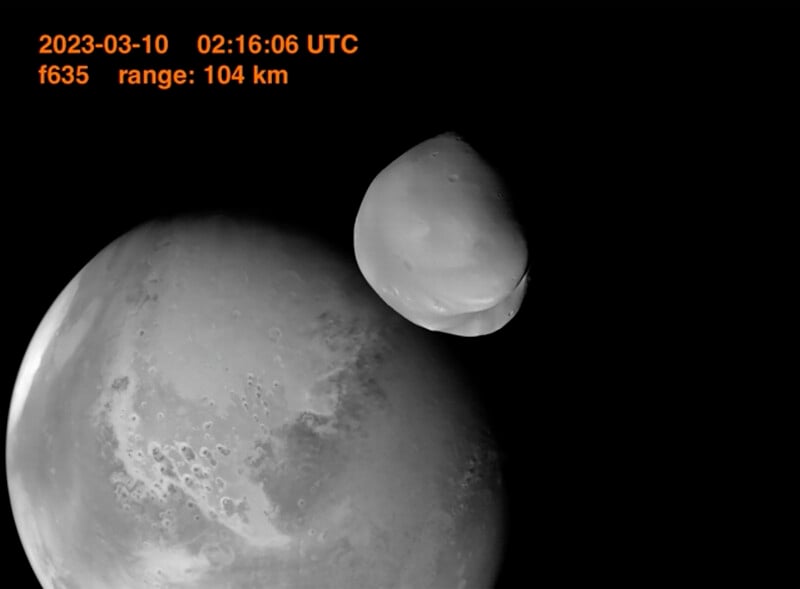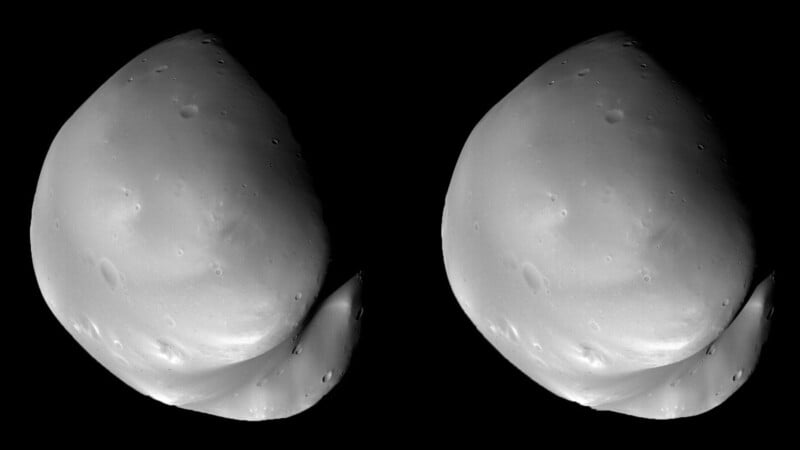Space Probe Captures Detailed Images of Mars’ Moon Deimos
![]()
The United Arab Emirates (UAE) Space Agency has unveiled the most-detailed images ever of Deimos, the smaller and outermost of Mars’ two natural satellites (the other is Phobos).
The UAE’s Amal spacecraft — “Amal” is “hope” in Arabic — flew within 62 miles (100 kilometers) of Deimos last month as part of the Emirates Mars Mission (EMM). It’s the closest a spacecraft has been to Deimos in nearly half a century.
The resulting close-up photos of Deimos were released today. PetaPixel first saw the images on Sky News, although Washington Post has also reported the news.

The images of Deimos are spectacular not only for their unprecedented resolution but that Mars “photobombed” the shots. The foreground moon looks much larger than its size. The odd-shaped, heavily-crated moon is just 9 miles by 7 miles by 7 miles (15 kilometers by 12 kilometers by 12 kilometers).
Deimos is also much farther from Mars than it appears, orbiting the red planet from a distance of about 14,580 miles (23,460 kilometers), a distance considerably farther than Phobos, which is just 3,700 miles (6,000 kilometers) from Mars.

Deimos’ orbit around Mars is very close to Amal’s inner orbital path, which made Deimos a desirable target, according to the mission’s lead scientist, Hessa al-Matroushi. “Phobos has got most of the attention up until now — now it’s Deimos’ turn,” she tells Washington Post.
في سابقة عالمية جديدة … مشروع الإمارات لاستكشاف المريخ "مسبار الأمل" يقترب لمسافة ١٠٠ كم من القمر التابع للمريخ "ديموس" .. ويلتقط أوضح صورة حصل عليها البشر لهذا القمر …
تخبرنا النظريات بأن هذا القمر هو كويكب خارجي تم التقاطه ضمن مدار المريخ .. ويدحض مسبار الأمل هذه النظرية… pic.twitter.com/JDOy1fpn6B
— HH Sheikh Mohammed (@HHShkMohd) April 24, 2023
The new photos of Deimos offer essential insight into its history and origins. The leading theory on Deimos has long been that it is an asteroid pulled into Mars’ orbit. However, the Amal research team says that the images show that Deimos appears to be of Martian origin, perhaps from the planet itself or its sibling moon, Phobos.
Amal will continue to orbit near Deimos, although it won’t get closer than last month. Amal got almost as close as NASA’s Viking 2 spacecraft, which came within 19 miles (30 kilometers) of Deimos in 1977.
The recent flyby is part of the UAE’s larger Mars mission, which scientists hope will uncover new details about Mars and its moons.
“How exactly [Phobos and Deimos] came to be in their current orbits is also an active area of study, and so any new information we can gain on the two moons, especially the more rarely observed Deimos, has the potential to unlock understanding of Mars’ satellites. Our close observations of Deimos so far point to a planetary origin” explains al-Matroushi.
Image credits: UAE Space Agency